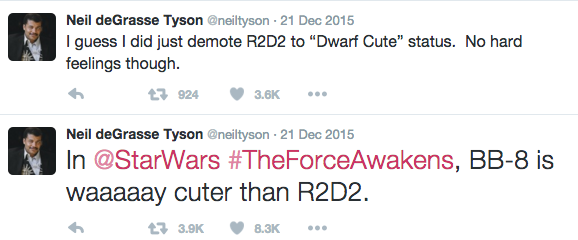There are few astrophysicists who can claim a Twitter following of nearly 5 million people.
The reality is that even as science becomes ‘cooler’, and is accepted by a broader population as the true basis for our galaxy and that which inhabits it, the scientists themselves aren’t generally considered any cooler than ever.
Neil deGrasse Tyson is a rare exception for a simple reason: he knows how to talk to a society hungry for scientific knowledge, but which lacks the understanding necessary to decode most of the discoveries his peers are publishing in industry journals. Whether it’s via breakdowns of the science in films, ostracising Pluto, or through his various television and podcast appearances, Tyson has helped fuel an unprecedented interest in the universe.
THE BIG BANG
It all started at age nine, Neil DeGrasse Tyson stepped into the Hayden Planetarium for the first time, and in the stars he found his future.
“so strong was that imprint [of the night sky] that I’m certain that I had no choice in the matter, that in fact, the universe called me.”
By age 15, he was already giving lectures, and gaining the attention of his future peers. Two years later, he was invited to tour Cornell University by none other than acclaimed astrophysicist Carl Sagan who, at the time, was the most prominent face in the scientific community. At the end of the day, Sagan gifted Tyson a copy of his book, signing it ‘to a future astronomer’.
“I already knew I wanted to become a scientist, but that afternoon I learned from Carl the kind of person I wanted to become.”
Still, Tyson was met with tribulation. As a black man growing up in New York, he was often asked by teachers why he wasn’t interested in pursuing a career as an athlete rather than as a scientist. Still to this day, Tyson’s race has played a major part in how he’s perceived in society. The moniker ‘Black Science Man’ is often prescribed to him by both supporters and those whose sole endeavour is to insult and belittle.
He attended Harvard University, where he spent his time between studying and his interest in rowing, wrestling, and dance. After graduating with a bachelor’s in physics and a master’s in astronomy from the University of Texas, his attempt at a doctorate was dissolved, and he was told to consider an alternate career path.
Such a setback wasn’t going to slow him down though. He refocused his efforts, and received his PhD in astrophysics at Colombia University in 1991.
DEEP IMPACT
In 1996, Tyson was appointed director of the Hayden Planetarium: the initial source of his love for the stars. 20 years later, he remains in this position.
Over the next two decades, Tyson made many other significant impacts on the world of science. He served on two government commissions helping to define the future of U.S. space travel, receiving as a result the highest civilian honour bestowed by N.A.S.A: The N.A.S.A Distinguished Public Service Medal.
Perhaps Tyson’s biggest impact on astrophysics – and science classrooms around the world – was his rejection of the belief that Pluto could be considered the ninth planet in our galaxy. In 2006, the International Astronomical Union reclassified Pluto as a dwarf planet, inspiring heated debate in the science community that continues to this day.
It was around this time that Tyson began to enter the public eye. Though he had been writing for Natural History magazine since 1995, written several books, and appeared in various television programs, the alienation of Pluto made him a popular guest on late night talk shows and news broadcasts around the world. The following year, he became a regular guest on the History Channel’s series The Universe, marking that start of a heavy shift towards engaging the public in science.
STAR TALK
Tyson launched StarTalk in 2009, and in so doing introduced a larger community to his mix of pop-culture inspired humour and ability to discuss science on an educational, but easily digestible, level. The podcast was pioneering, uniting the planes of geekdom in a unique and exciting way.
That same year, Tyson signed up to Twitter, and brought his same brand of contemplative, inciting humour to its millions of users. Taking on topics from religion to gun control, Tyson inspires discussion without resorting to insult. His Christmas-themed post from 2014 is a great example.

When he’s not dismantling the foundations of human civilisation, Tyson often turns his attention to the science of films. His serious response to films like Gravity and Interstellar have been the topic of international media, while live-tweeting of Star Wars: The Force Awakens, seemed more like a labour of love.

Tyson hosted the reboot of Carl Sagan’s television program Cosmos: A Personal Voyage entitled Cosmos: A Spacetime Odyssey in 2014. Since then, the show has been broadcast in dozens of countries worldwide, and went on to win a Peabody award for educational content.
In 2015, the U.S. National Academy of Sciences awarded Tyson the Public Welfare Medal for his work in “exciting the public about the wonders of science”.
It’s an award well-deserved. Truly, there is nobody else in the scientific community that has the ability to draw our attention to what lies beyond, and make us reflect on our existence under the stars.
You can follow Neil deGrasse Tyson on Twitter here.
